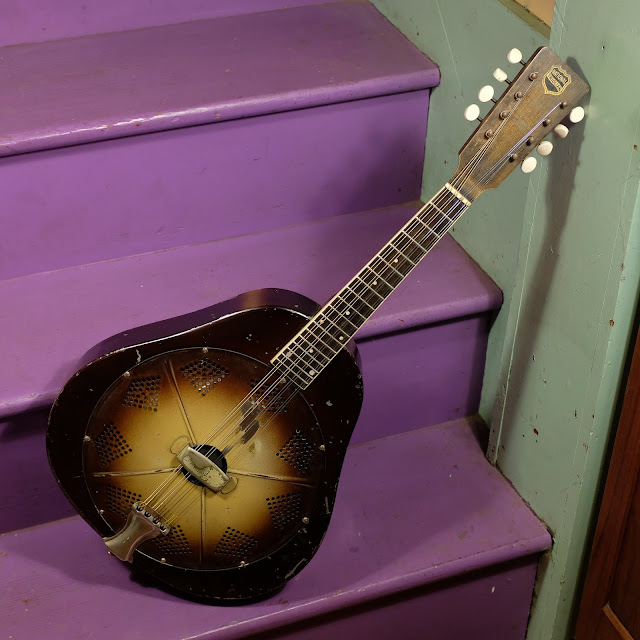1930 National Triolian Resonator Mandolin
Resonator mandolins are not easy to find. This one was sent-up by a customer for work and consignment, though I'm quite tempted myself. Years ago, I had a great Supro-branded National resonator mandolin along the same lines and I still kick myself a bit for trading it off.
Aside from the fact that these instruments are metal-bodied, aluminum-coned, resonator mandolins, they're also "not like normal mandolins" in other ways, too -- they have a wider nut and a long, 15" scale which, if this were made by the specs of bowlback mandolins in the early 1900s, would've meant it's technically a mandola. It's thus that only a daredevil who wants to roll the dice on the neck that actually tunes one of these up to proper GDAE pitch using anything but the very lightest strings (I suggest 32w-9 at max for that -- and even then they'll feel tense). In this case I have it strung with 34w-10 gauges and tuned down a step and a half to EBF#C# low to high. A capo on fret 3 gives standard GDAE. This opens-up the guitar-friendly keys of E and B without a capo.
Probably the nicest thing about these National instruments is the girth of the tone and the responsiveness. Generally, one has to hammer on even the best bluegrass mandolin to get them to punch-out and compete with the rest of the band. On these, you can use a light touch and so have a lot more dynamic range (and the ability to play sweet and with volume) to play with. It's almost like playing an electric instrument. The doubled strings and size of the body mean that despite being a resonator design, the tone is still a lot closer to that of a "normal" mandolin to the average ears than a resonator guitar is to a flattop guitar.
Work included: a fret level/dress, minor neck angle adjustments and stabilization, new binding on the fretboard, general cleaning, a new compensated bone saddle, and a good setup. It has a straight neck, plays with 1/16" action at the 12th fret, and sounds glorious. Strings are 34w, 24w, 14, 10 phosphor bronze and it's tuned EBF#C# below normal GDAE.
Scale length: 15"
Nut width: 1 9/32"
String spacing at nut: 1 1/16"
String spacing at saddle: 1 9/16"
Nut width: 1 9/32"
String spacing at nut: 1 1/16"
String spacing at saddle: 1 9/16"
Body length: 13"
Body width: 12 5/8"
Body width: 12 5/8"
Side depth at endpin: 2 1/2"
Neck wood: maple
Fretboard: ebonized maple
Fretboard: ebonized maple
Neck shape: flat board, mild-to-medium C-shaped rear
Bridge: original maple biscuit
Nut: original bone
Saddle: new, compensated bone
Condition notes: fretboard binding is replacement, the tuners are '50s-era replacements, the saddle is replacement, but everything else is original. I added a duct-tape "gasket" to the soundwell as I do on any old resonator instrument, as the original felt gasket was completely falling apart. The replacement '50s Harmony-style tuners came with the instrument but are not the best -- you definitely need to tune them up to pitch rather than down. The body shows plenty of mild wear and tear but it has no major dings or bumps. It looks great for its age. There are two replacement pearl dots in the board. The cone is original and has the original, small, black-painted maple biscuit.
National's idiosyncratic color choices are always engaging.
The maple neck was originally stained a dark brown, I'd assume, but years have given it a greeny-grey-brown color.
The ebonized maple fretboard has two replacement pearl dots at its end (which cover tiny fretboard extension mounting screws). The board itself has some old hairline dryness cracks which are stable and have been filled a bit.
The serial number 569 W points to 1930 as the year of manufacture.















Comments
Thanks, and as always an informative blog and great instrument!
Willie Wilson
In addition, I also use a bit of aluminum foil tape (2 small strips) to "lock" the cone in position so it won't rotate or move around by accident if someone destrings an instrument entirely. I tape these to the edge of the lip of the cone and then up the wall of the soundwell, using a screwdriver to smooth it down flush.